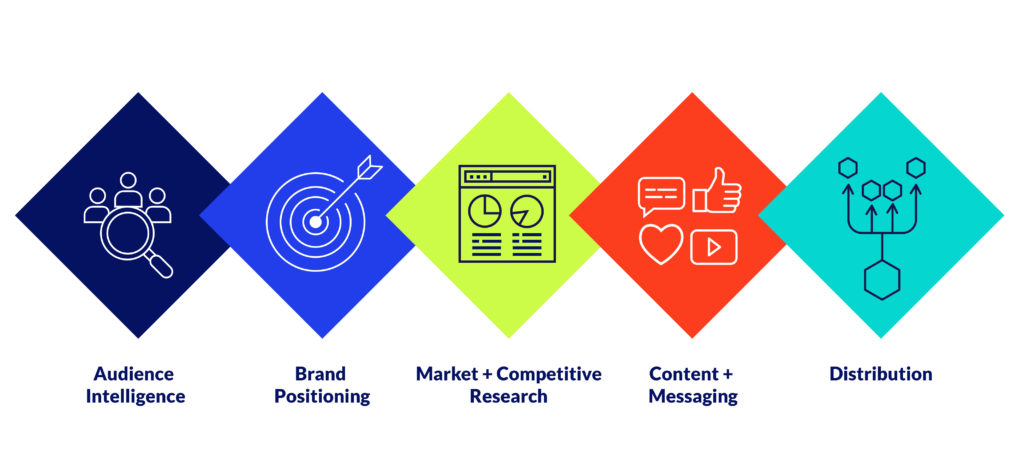How can we help you?
We want to hear from you. And it’s easy to reach us. Give us a shout at 844-886-2252, send us an email at hello@mediumgiant.co, visit our contact page, or fill out the form right here. You can expect a response within two business days.
What are you looking for?
Why you need a content strategy and how to build one that works
Content marketing is more important than ever. According to HubSpot trends, marketing leaders are prioritizing content roles at their companies in 2022.
Inbound marketing — luring potential customers to you by creating valuable content and experiences that cater to their needs and wants — is not new. But in an internet age focused on privacy, anti-spam sentiment, and a cookieless future, it has never been more essential for a business.
As outbound strategies and performance marketing become increasingly more challenging, executives are requesting thought leadership and content from their marketing teams. Plus, any good marketer knows that inbound and outbound efforts must work together to achieve marketing goals.
But your content will not have an impact on your marketing efforts unless you have a strategy in place to start.
Think of content as an asset, not an expense.
Through inbound marketing, you’re inviting potential customers to engage, rather than interrupting them with messages they may not want (at least not in that moment). Content marketing is the beating heart of inbound.
As our pals at the Content Marketing Institute like to say, “Content marketing is a strategic marketing approach focused on creating and distributing valuable, relevant, and consistent content to attract and retain a clearly defined audience — and, ultimately, to drive profitable customer action.” That last bit is important, because although your content should focus on solving your prospects’ problems, and not on selling to them, the endgame is always to convert that prospect into a customer, and a repeat one at that.
Creating demand for your product or service with content is a long-term play with lasting benefits. How does it work?
- Establish authority. Own the space in which you operate. You have wisdom to impart. Be a publisher — but always in service to your customers, not yourself.
- Build trust. When you have authority, people trust you. If you give them something of value regularly, you’ll be top of mind when they’re ready to buy.
- Increase qualified site traffic. The more quality content you create, the more visitors you lure to your website. (Emphasis on the word “quality.”) You want them to stick around when they get there, plus inspire repeat visits.
- Connect better. People tend to ignore ads. But they’ll stop scrolling for something educational, entertaining, or helpful. That’s how you make more meaningful connections.
- Influence sales. When people trust you, they’re more likely to listen to your sales pitch. Content can even be the thing that seals the deal.
- Inspire loyalty. Your customer relationship doesn’t end when the sale closes. Keep delivering valuable content to inspire repeat business and referrals.
More than 47% of buyers interact with at least five pieces of content before engaging a salesperson to make a purchase. Content raises brand visibility and generates demand to make the buying decision — and salespeople’s jobs — easier.
The market is shifting. Trends in advertising, the economy, and technology have forced marketers to approach their jobs differently. Lead generation, especially for B2B companies, has long been the priority. But that is shifting, as marketers and their leaders are beginning to understand the importance of demand generation.
And demand generation is best achieved through a quality content strategy.
A quality content strategy answers these questions.
All strategies take time, research, and planning to be effective — and by effective we mean achieving the desired results. Use these questions as your guide when building your content strategy:
Who is the target audience?
Determine who is most likely to engage with your content and, ultimately, make a purchase. If you attempt to write for everyone, you may not connect with anyone. Know what’s important to your target audience, what problems they’re trying to solve, and create content that meets those needs.
What unique value do you provide to consumers that distinguishes you from your competitors?
This is where your brand positioning comes in. Your company’s differentiators — and, more important, how they benefit your target audience — point you toward the appropriate content themes, ones you have a right to own. At its simplest, a solid content strategy expresses where the audience’s needs and the brand’s strengths intersect.
What content will you create and what messages will you communicate to meaningfully connect with potential customers?
As mentioned above, audience needs and wants, plus your brand positioning, equal your content pillars. Stay inside those pillars, creating content that speaks directly to what’s important to them and how you’re in a unique position to provide it.
Where are your prospects in the buying journey and where are they most likely to see — and act on — your content?
In general, your prospects fall into one of these categories:
- Unaware. People inside your target market who may not realize they have a problem or need.
- Problem-aware. People inside your target market who know they have a problem or need.
- Solution-aware. People inside your target market who know there are solutions out there, whether they’re products, tools, or services, that solve the problem or need.
- Brand-aware. People inside your target market who are learning about the brands that solve their problem or need, and are evaluating them based on factors such as price, expertise, or innovation.
Even though the journey is not linear — in fact, it’s often a long and winding road — your content strategy has to consider the customer mindset during all of these phases so you can plan content accordingly. As part of this journey mapping, look to your audience intelligence to tell you where these people consume content and their media preferences so you can prioritize the most valuable touchpoints and channels.
What actions do you want people to take and how will you measure the success of your content marketing program?
Once you’ve figured out your priority marketing channels, establish key performance indicators (KPIs) to measure success within them, laddering up those metrics to overarching marketing objectives and business goals. Filling the pipeline by helping prospects along their journey and simultaneously building their confidence in your brand are as important as those sales appointments and final transactions.
How to build a content strategy
Medium Giant uses key steps to build a strategy that your content team can execute on. The cornerstone of our strategy is in research, and that’s why the first three steps are focused on gathering information that will lead to insights.

Audience intelligence
Yes, it’s marketing 101: Don’t embark on any marketing initiative — content or otherwise — without knowing your customer: who they are, where they are, what’s important to them, what types of media they like to consume, and where they like to consume it.
In a perfect world, you have quantitative and qualitative data that helps paint a picture of not only your top customers, but also your next best prospects. We find it helpful to start with customer segmentation and analyze your customer database to identify top-tier prospects by lifetime value and churn rate. This information will be immediately valuable in building lookalike audiences in media campaigns or reengaging lapsed customers through remarketing campaigns.
However, don’t despair if you haven’t dug deeply into your first-party data for these insights. Even one-on-one interviews or focus groups with those “best fit” customers can provide meaningful information about whom you’re trying to reach and how. These qualitative insights are what fuels the messaging strategy.
Brand positioning
As we mentioned above, the value you provide to your customers, and the reasons to believe that’s true, help to establish where you want to focus your content marketing efforts. A solid grasp on your brand positioning and your target audience forms the foundation of your content strategy.
Ideally you have done the work, and preferably with people who do it for a living, to formalize your brand strategy. But even getting your key stakeholders in the room to hash out a few key inputs is a good start, to determine your positioning, your core strength and character, the essence of who you are, and the promise you make to your customers.
We like to use a framework dubbed a “connection map” that details where your brand attributes connect with the needs and values of your target audience, culminating in an organizing idea. That organizing idea — which should activate behavior, seek participation with and for people, inspire experiences, use brand tone and style, and deliver brand purpose — acts as the guiding light for all content and messaging.
Market and competitive research
To understand your opportunity and how your brand can woo consumers with content, you have to investigate what’s happening in your industry and out in the world. Review industry trends and reports, look at what your competition is doing, and research shifts in consumer behavior that affect businesses in every vertical, not just yours.
These insights add a layer of intelligence that can help you further refine messaging and distribution, plus maximize reach and return.
Content and messaging
Armed with your audience intelligence, brand positioning, and market research, you’re ready to clearly define your content pillars — the areas in which you have a right to assert authority through content. Also, be sure to articulate the impact this content can have on your audience and the opportunity it presents to the brand.
We have a framework called a “content map” that not only names the content pillars but also reminds us of the marketing objectives, the organizing idea, and the impact to the customer. Like the connection map, the content map synthesizes key learnings and establishes a strategic direction for content development.
Distribution
Remember those media preferences you uncovered during audience intelligence? That’s how you know where to publish your content because you want it to be where your prospects are most likely to see and engage with it.
As part of this exercise, you want to identify the most critical channels — organic and paid — and what your customers may be thinking at those touchpoints. The “journey map,” as we like to call it, can be complex, but strive for simplicity wherever possible. Where does that content show up? In what form? What’s the key takeaway? What metrics matter for that interaction?
Although content is more commonly associated with inbound marketing, the reality is your content strategy has broader influence — as it should, because your outbound and inbound efforts need to be in sync to create consistent customer experiences and drive the same business goals.
A content strategy takes work, but it’s worth it.
True, a content strategy can be a massive undertaking. But if you take the time to do it, your content will have the desired effect: speaking directly and authentically to your audience about their needs and wants.
Just as important, a content strategy is crucial for your creators, whether internal or external, so that everyone is operating from the same playbook, in service of the same goals.
Speaking of goals, remember that content marketing is a long game, one that culminates in that coveted profitable customer action. But there are many wins along the way that your content strategy can help secure. And those are worth celebrating too.
Why you need a content strategy and how to build one that works
Content marketing is more important than ever. According to HubSpot trends, marketing leaders are prioritizing content roles at their companies in 2022.
Inbound marketing — luring potential customers to you by creating valuable content and experiences that cater to their needs and wants — is not new. But in an internet age focused on privacy, anti-spam sentiment, and a cookieless future, it has never been more essential for a business.
As outbound strategies and performance marketing become increasingly more challenging, executives are requesting thought leadership and content from their marketing teams. Plus, any good marketer knows that inbound and outbound efforts must work together to achieve marketing goals.
But your content will not have an impact on your marketing efforts unless you have a strategy in place to start.
Think of content as an asset, not an expense.
Through inbound marketing, you’re inviting potential customers to engage, rather than interrupting them with messages they may not want (at least not in that moment). Content marketing is the beating heart of inbound.
As our pals at the Content Marketing Institute like to say, “Content marketing is a strategic marketing approach focused on creating and distributing valuable, relevant, and consistent content to attract and retain a clearly defined audience — and, ultimately, to drive profitable customer action.” That last bit is important, because although your content should focus on solving your prospects’ problems, and not on selling to them, the endgame is always to convert that prospect into a customer, and a repeat one at that.
Creating demand for your product or service with content is a long-term play with lasting benefits. How does it work?
- Establish authority. Own the space in which you operate. You have wisdom to impart. Be a publisher — but always in service to your customers, not yourself.
- Build trust. When you have authority, people trust you. If you give them something of value regularly, you’ll be top of mind when they’re ready to buy.
- Increase qualified site traffic. The more quality content you create, the more visitors you lure to your website. (Emphasis on the word “quality.”) You want them to stick around when they get there, plus inspire repeat visits.
- Connect better. People tend to ignore ads. But they’ll stop scrolling for something educational, entertaining, or helpful. That’s how you make more meaningful connections.
- Influence sales. When people trust you, they’re more likely to listen to your sales pitch. Content can even be the thing that seals the deal.
- Inspire loyalty. Your customer relationship doesn’t end when the sale closes. Keep delivering valuable content to inspire repeat business and referrals.
More than 47% of buyers interact with at least five pieces of content before engaging a salesperson to make a purchase. Content raises brand visibility and generates demand to make the buying decision — and salespeople’s jobs — easier.
The market is shifting. Trends in advertising, the economy, and technology have forced marketers to approach their jobs differently. Lead generation, especially for B2B companies, has long been the priority. But that is shifting, as marketers and their leaders are beginning to understand the importance of demand generation.
And demand generation is best achieved through a quality content strategy.
A quality content strategy answers these questions.
All strategies take time, research, and planning to be effective — and by effective we mean achieving the desired results. Use these questions as your guide when building your content strategy:
Who is the target audience?
Determine who is most likely to engage with your content and, ultimately, make a purchase. If you attempt to write for everyone, you may not connect with anyone. Know what’s important to your target audience, what problems they’re trying to solve, and create content that meets those needs.
What unique value do you provide to consumers that distinguishes you from your competitors?
This is where your brand positioning comes in. Your company’s differentiators — and, more important, how they benefit your target audience — point you toward the appropriate content themes, ones you have a right to own. At its simplest, a solid content strategy expresses where the audience’s needs and the brand’s strengths intersect.
What content will you create and what messages will you communicate to meaningfully connect with potential customers?
As mentioned above, audience needs and wants, plus your brand positioning, equal your content pillars. Stay inside those pillars, creating content that speaks directly to what’s important to them and how you’re in a unique position to provide it.
Where are your prospects in the buying journey and where are they most likely to see — and act on — your content?
In general, your prospects fall into one of these categories:
- Unaware. People inside your target market who may not realize they have a problem or need.
- Problem-aware. People inside your target market who know they have a problem or need.
- Solution-aware. People inside your target market who know there are solutions out there, whether they’re products, tools, or services, that solve the problem or need.
- Brand-aware. People inside your target market who are learning about the brands that solve their problem or need, and are evaluating them based on factors such as price, expertise, or innovation.
Even though the journey is not linear — in fact, it’s often a long and winding road — your content strategy has to consider the customer mindset during all of these phases so you can plan content accordingly. As part of this journey mapping, look to your audience intelligence to tell you where these people consume content and their media preferences so you can prioritize the most valuable touchpoints and channels.
What actions do you want people to take and how will you measure the success of your content marketing program?
Once you’ve figured out your priority marketing channels, establish key performance indicators (KPIs) to measure success within them, laddering up those metrics to overarching marketing objectives and business goals. Filling the pipeline by helping prospects along their journey and simultaneously building their confidence in your brand are as important as those sales appointments and final transactions.
How to build a content strategy
Medium Giant uses key steps to build a strategy that your content team can execute on. The cornerstone of our strategy is in research, and that’s why the first three steps are focused on gathering information that will lead to insights.

Audience intelligence
Yes, it’s marketing 101: Don’t embark on any marketing initiative — content or otherwise — without knowing your customer: who they are, where they are, what’s important to them, what types of media they like to consume, and where they like to consume it.
In a perfect world, you have quantitative and qualitative data that helps paint a picture of not only your top customers, but also your next best prospects. We find it helpful to start with customer segmentation and analyze your customer database to identify top-tier prospects by lifetime value and churn rate. This information will be immediately valuable in building lookalike audiences in media campaigns or reengaging lapsed customers through remarketing campaigns.
However, don’t despair if you haven’t dug deeply into your first-party data for these insights. Even one-on-one interviews or focus groups with those “best fit” customers can provide meaningful information about whom you’re trying to reach and how. These qualitative insights are what fuels the messaging strategy.
Brand positioning
As we mentioned above, the value you provide to your customers, and the reasons to believe that’s true, help to establish where you want to focus your content marketing efforts. A solid grasp on your brand positioning and your target audience forms the foundation of your content strategy.
Ideally you have done the work, and preferably with people who do it for a living, to formalize your brand strategy. But even getting your key stakeholders in the room to hash out a few key inputs is a good start, to determine your positioning, your core strength and character, the essence of who you are, and the promise you make to your customers.
We like to use a framework dubbed a “connection map” that details where your brand attributes connect with the needs and values of your target audience, culminating in an organizing idea. That organizing idea — which should activate behavior, seek participation with and for people, inspire experiences, use brand tone and style, and deliver brand purpose — acts as the guiding light for all content and messaging.
Market and competitive research
To understand your opportunity and how your brand can woo consumers with content, you have to investigate what’s happening in your industry and out in the world. Review industry trends and reports, look at what your competition is doing, and research shifts in consumer behavior that affect businesses in every vertical, not just yours.
These insights add a layer of intelligence that can help you further refine messaging and distribution, plus maximize reach and return.
Content and messaging
Armed with your audience intelligence, brand positioning, and market research, you’re ready to clearly define your content pillars — the areas in which you have a right to assert authority through content. Also, be sure to articulate the impact this content can have on your audience and the opportunity it presents to the brand.
We have a framework called a “content map” that not only names the content pillars but also reminds us of the marketing objectives, the organizing idea, and the impact to the customer. Like the connection map, the content map synthesizes key learnings and establishes a strategic direction for content development.
Distribution
Remember those media preferences you uncovered during audience intelligence? That’s how you know where to publish your content because you want it to be where your prospects are most likely to see and engage with it.
As part of this exercise, you want to identify the most critical channels — organic and paid — and what your customers may be thinking at those touchpoints. The “journey map,” as we like to call it, can be complex, but strive for simplicity wherever possible. Where does that content show up? In what form? What’s the key takeaway? What metrics matter for that interaction?
Although content is more commonly associated with inbound marketing, the reality is your content strategy has broader influence — as it should, because your outbound and inbound efforts need to be in sync to create consistent customer experiences and drive the same business goals.
A content strategy takes work, but it’s worth it.
True, a content strategy can be a massive undertaking. But if you take the time to do it, your content will have the desired effect: speaking directly and authentically to your audience about their needs and wants.
Just as important, a content strategy is crucial for your creators, whether internal or external, so that everyone is operating from the same playbook, in service of the same goals.
Speaking of goals, remember that content marketing is a long game, one that culminates in that coveted profitable customer action. But there are many wins along the way that your content strategy can help secure. And those are worth celebrating too.




